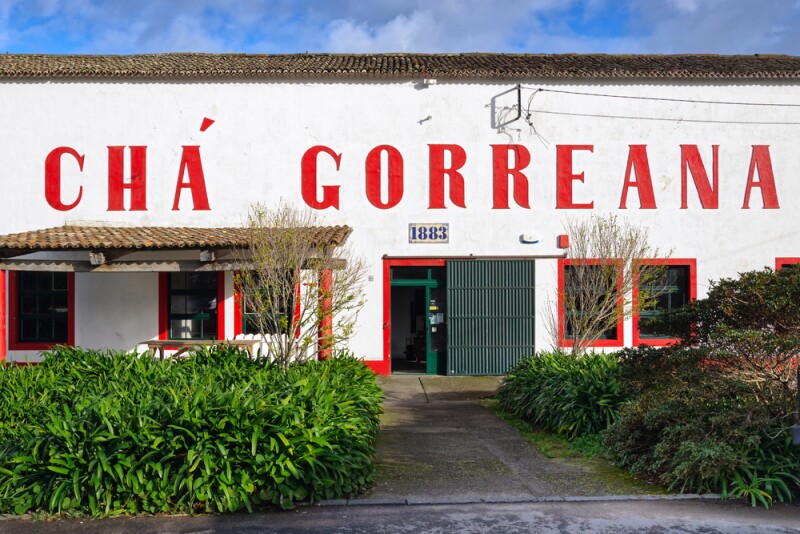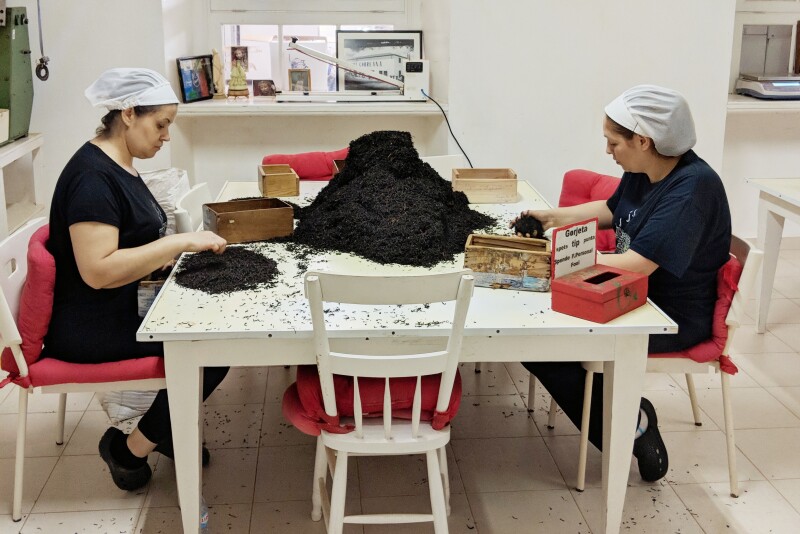The aroma hits you as soon as you enter Chá Gorreana. A little earthy, a little moist, as if humidity had a scent. A loud whew whew whew of 19th-century machines thunders in your ears. These are the smells and sounds of Europe’s oldest tea factory, which has been operating on the Azorean island of São Miguel since 1883.
Today, Chá Gorreana produces 44 tons of tea a year, exporting its award-winning green and black teas to mainland Portugal, England, Germany, the United States, and beyond. Although that tonnage is much lower than during its heyday in the 19th century, the same traditional machinery is in use as when the company began more than 100 years ago.
You might expect the United Kingdom and Ireland to be Europe’s tea capitals, and they are (along with Turkey)—for consumption, with residents imbibing at least four pounds of tea per person annually in 2016. But most of the teas, including those by the nation’s most purchased brands like PG Tips and Tetley, are grown far afield in places like Africa and Southeast Asia, due to climate.
Tea wasn’t always a main economic crop for the Azores. In fact, the nine-island volcanic archipelago, an autonomous region located about 900 miles west of mainland Portugal, used to rely on oranges as its export until the 19th century, shipping tens of millions a year. However, in the mid-1800s, blight struck the crops and growers soon had to find a new source of income.

Chá Gorreana was founded in 1883.
Photo by tetiana_u/Shutterstock.com
Items like passion fruit, bananas, and other produce that are now considered typical in the Azores, entered the islands around that time in an attempt to jump-start the economy. “In this package of new crops we brought in to try to get the economy going again,” says Rui Amen of the Azores Promotion Board, “you have tea.” It turned out that the humid subtropical climate of the Azores and their acidic volcanic soils make for perfect weather and growing conditions for a variety of produce and plants. “We had the right soil and weather,” Amen says. “We just needed to bring somebody in who could teach us how to produce it.”
An expert from China and his assistant were hired to bring tea seeds and teach local entrepreneurs how to grow the tea. One of those entrepreneurs was Ermelinda Gago da Câmara, one of the farmers affected by the orange blight. Along with her son José Honorato, she founded Gorreana; the business is on its sixth generation of family ownership.
It was a gamble to bet on tea production, in part because it was a huge investment. Unlike growing a tree crop, tea involved machinery—lots of it. Tea not only needs growing; it also needs picking, withering, dehydrating, oxidizing, fermenting, drying, rolling, and selecting the right leaves. In addition to the work opportunities tea provided, it brought in new (and expensive) technologies. “In those days, it was like trying to get a place in the space shuttle,” says Amen.

Some tasks, like sorting the tea leaves, are still done by hand.
Photo by Sara Button
Gorreana was also one of the first places in São Miguel to have electricity. The traditional machines—once the height of tech in the 19th century—are still used in the tea factory and prove to be easier to manage than you might think. “They are easier to repair than the new machines because you don’t have to ask someone who knows about electricity and computers to fix them,” says Maddalena Motta, a descendant of Gago da Câmara and press representative for the company. They also run on hydropower, which has also allowed the business to stay afloat when other tea factories in the Azores closed their doors.
A visit to Chá Gorreana, once a testament to new innovations introduced by forward-thinking Azorean businessfolk, is now a glimpse into the past. And though there have been ups and downs, moving into the next generation of ownership, the factory is surviving, continuing to sell its product locally and internationally, as well as to tourists who visit. “Tea was the beginning of the end of the orange,” says Motta. “So we’re a family that knows how to fight with something that ends. I think our secret is, when it’s the good time, we work for the bad times; when the bad times come, we are strong to fight with them.”

Chá Gorreana makes green tea and black tea (and you can try both when you visit).
Photo by Sara Button
If you go
When to visit
Tea harvest runs between April and October. Motta recommends visiting in September (or May) to experience the best weather and the least number of tourists. Delta began offering seasonal direct flights from New York City to São Miguel this summer, and Azores Airlines flies there directly from Boston year-round.
Getting there
Chá Gorreana is open to the public daily. Visitors can see the factory on their own (don’t skip the tasting room, where you can sip Gorreana’s varieties of black and green teas!), or book a private tour for in-depth information about every step in the tea-making process with companies such as Azores Getaways (starting at $75/person).
Also worth a peek, if only for the views, is Chá Porto Formoso, the only other operating tea factory in Europe, conveniently down the road from Chá Gorreana.

Tea fields at Cha Gorreana
Photo by KajzrPhotography/Shutterstock.com
Where else to play
Like its siblings, São Miguel is an ideal place for nature lovers. Rent a car and explore the island: Watch the sunset over a trio of volcanic lakes at the Boca do Inferno viewpoint, swim in the mix of cold Atlantic waters and natural hot springs at Ponta da Ferraria, or try paragliding for a different point of view. Easy flight connections are available to the other islands.
Where to stay
The island of São Miguel is small enough to make almost any hotel a base for exploration. Try booking a room (and taking a relaxing dip in the thermal pools) at the historic Terra Nostra Garden Hotel, about a 15-minute drive from the tea plantation. To be in the middle of the historic city center of the Azores’ capital, book a room at Casa Hintze Ribeiro in Ponta Delgada.
Writer Sara Button traveled courtesy of Delta and Azores Getaways, a tour operator that offers customizable, all-inclusive packages. Other tour options can be found here, including operators like the U.S.-based, Azores-specialized Tour Azores.
>>Next: The Azores Are the Perfect Island Getaway—and They’re Closer Than You Think











